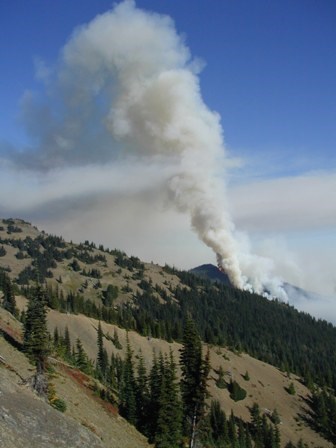
NPS Photo Given the Olympic Peninsula's reputation for rain, one might expect the forests to be impervious to fire. The evidence of tree rings, charcoal analysis, forest composition and structure, however, tells a different story. Long periods of time with scattered small fires of low to moderate intensity have been punctuated by infrequent, but very intense, fires that kill most of the trees in their path. Historic experience with a few large fires indicates that it takes a combination of circumstances - a source of ignition (like lightning), severe drought and prolonged east winds - for burns in the Olympics to become large. This cycle of fire and regeneration is a historically important factor to the Park's ecosystem. Some of the effects of past fires are evident in the patchwork appearance of the forest landscape. Looking over the Morse Creek and Elwha River drainages, one can see fine textured patches of young even-aged trees, which contrast with the surrounding old growth forest whose tall, widely-spaced canopy presents a coarser texture. The outline of the patches reflects the outline of large fires that occurred in the past century. For many centuries fire was the primary large-scale disturbance factor on the east side of the peninsula. The reoccurring influence of fire favored the establishment and perpetuation of forests dominated by large, thick-barked and fire-resistant Douglas-fir trees. On the west side of the peninsula, however, large fires occurred less frequently, which allowed fire-sensitive species such as western hemlock and sitka spruce to gain dominance. At high elevation, patches of subalpine fir forest burned when lighting events were coupled with dry conditions. When fire burns into the tops of the trees, it creates patches of sunny open land in the otherwise dense forest. Wildflowers and shrubs take over in turn, perpetuating a cycle that has created a diverse mosaic of forest canopy and fire-induced meadows. As such, natural wildfire has contributed immensely to the uniqueness of the Park's plants and animals. While previous policies called for almost universal fire suppression, park managers now understand the important role naturally occurring forest fires play in the ecosystem. When a fire is determined to be of little threat to safety or property, it is allowed to burn naturally so as to maximize such benefits to the Park environment. |
Last updated: March 28, 2025
